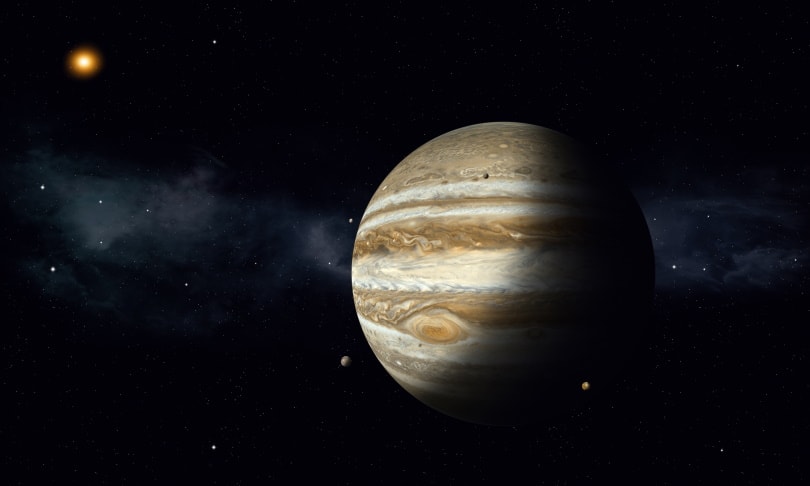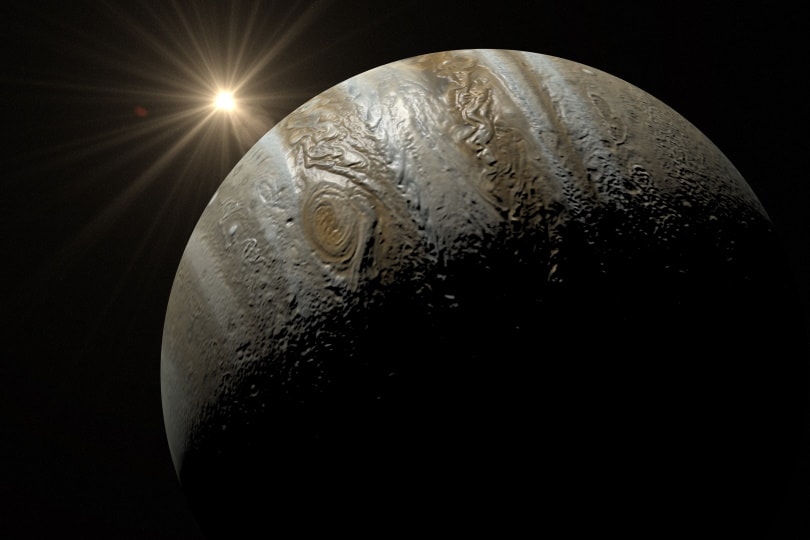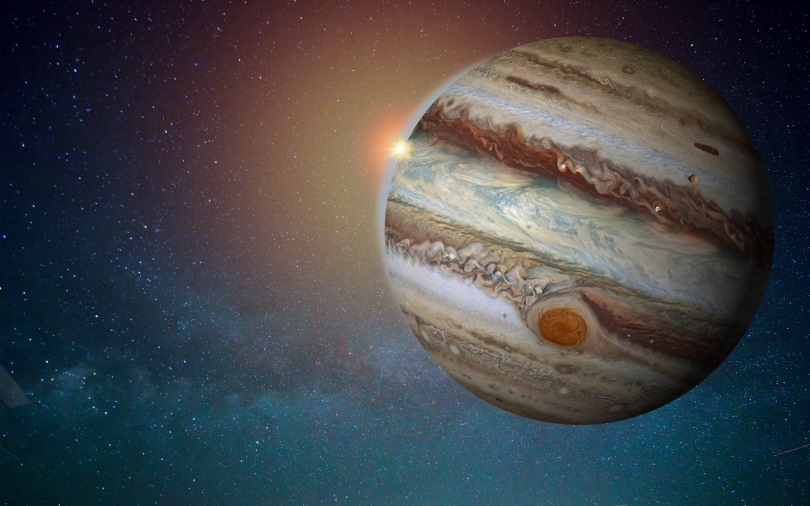How Far Away Is Jupiter? How Long Would it Take to Travel There?
Last Updated on

If you are interested in the fifth planet from the Sun, you’re not alone. This gas giant has been the object of awe and admiration for millennia, long before anyone even knew what to expect!
Now we have a better understanding of this behemoth of a planet, but there’s still plenty to explore. But how far away is Jupiter, and how long would it take to reach the planet? We answer those questions and more here.

How Far Away Is Jupiter From Earth?

To answer this question, we need to evaluate a few different factors. First, we need to understand that all planets travel in an elliptical pattern, which is an oval instead of a regular circle.
Each planet also travels on its own ellipse, which means that the distance between two planets is constantly changing, and there’s a wide range of options.
At its closest point, Jupiter is “only” 365 million miles away from Earth. That’s a considerable distance, but when you compare it to the 601 million miles away the planet is when at its farthest distance, it’s not that far.
This distance varies a ton, but it does it over many years. That’s because it takes 11.86 Earth years for a single year on Jupiter. So, during one year, Jupiter might be on the outer end of its ellipse almost the entire time, while during another, it might stay on its path closest to the Sun!
If you’re out stargazing, don’t worry too much about the distance. While it certainly makes a difference, Jupiter is so bright and large, you shouldn’t have any issues spotting it even if it’s at its farthest possible distance.
How Far Is Jupiter From the Sun?

Jupiter has an elliptical orbit, so there are periods when Jupiter is closer to the Sun. The closest moments, known as perihelion, put Jupiter 460 million miles from the Sun.
But on the other end of things, known as aphelion, it’s 508 million miles away. Between these two distances is the average distance that Jupiter spends from the Sun, at 484 million miles.
Considering the average distance that the Earth spends from the Sun is just under 73 million miles, that places Jupiter over 6.5 times as far away from the Sun as Earth!
Considering this extreme distance, you might assume that Jupiter is an extremely cold planet. However, while that’s true for the outermost layer of the planet, the vast majority of the planet is extremely hot. In fact, the hottest parts of the planet are even hotter than the surface of the Sun!
How Long Would It Take to Travel to Jupiter?

Trying to determine how long it would take to reach Jupiter is a moving math question. That’s because the answer depends on a variety of factors, namely how fast you’re moving, the current distance between Earth and Jupiter, and the fact that you need to decelerate to stay in orbit.
That’s why the best way to determine how long it would take to reach the fifth planet from the Sun is to look at past missions. Humanity has sent two orbiters to Jupiter, Galileo and Juno. It took Galileo six years to reach Jupiter, while Juno made the same journey in five years.
But the fastest that any object has traveled to Jupiter was the New Horizons mission. It still holds the record as the fastest object ejected from Earth, and it utilized a gravity assist from Jupiter to gain even more speed.
Since it’s the fastest object shot from Earth, and we sent it straight to Jupiter for a flyby, it’s an excellent tool for determining how long it would take if we’re not interested in orbiting the planet.
New Horizons launched on January 19, 2006, and on February 28, 2007, it made its closest approach to Jupiter at 1.4 million miles away. So, even with the best technology in the world and the sole objective of flying past Jupiter as fast as possible, it took a little over a year to reach the planet.
How Long Does It Take for Light to Reach Jupiter?

Whether you’re wondering how old the light is you’re looking at when you’re at Jupiter or you’re curious how long it takes to get data from the Juno mission, you’re really asking the same question: How long does it take for light to reach Jupiter from Earth?
The truth is that it changes drastically because of the elliptical motions and varying distances. At its closest approach, Jupiter is 32 light minutes and 39 light seconds away from Earth. But when the distance expands to its farthest point, Jupiter is 53 light minutes and 46 light seconds away!
But if you’re curious about how long it takes for light to reach Jupiter from the Sun, the numbers are a bit closer together, although they still vary. At its farthest point, Jupiter is 45 light minutes and 27 light seconds away from the Sun. Even when it’s at its closest point, though, the light left the Sun 41 minutes and 9 seconds earlier!
Finally, if you’re curious about how long ago the light that you’re viewing from Jupiter left the Sun, that number can vary anywhere from 1 light hour and 20 light minutes to 1 light hour and 14 light minutes. But while it’s an interesting number to think about, it doesn’t have any functional purpose.
- You might also like: What is The Bluewater Astronomical Society?

Conclusion
It seems that Jupiter doesn’t get all the love that it deserves in recent times. While it doesn’t have the big, impressive rings of Saturn, it still is the largest planet in the Solar System and has tons of vibrant colors to enjoy.
So, the next time that you dust off your telescope to check out the night sky, why not give an old target a new look? You might just be surprised by how much you can see!
Related Reads:
- How Big Is Jupiter?
- How Far Away Is Venus? How Long Would it Take to Travel There?
- How Far Is Neptune From the Earth?
Featured Image Credit: alexaldo, Shutterstock
About the Author Robert Sparks
Robert’s obsession with all things optical started early in life, when his optician father would bring home prototypes for Robert to play with. Nowadays, Robert is dedicated to helping others find the right optics for their needs. His hobbies include astronomy, astrophysics, and model building. Originally from Newark, NJ, he resides in Santa Fe, New Mexico, where the nighttime skies are filled with glittering stars.
Related Articles:
How to Collimate Binoculars: 9 Expert Tips
How to Clean a Refractor Telescope: Step-by-Step Guide
How to Clean a Telescope Eyepiece: Step-by-Step Guide
How to Clean a Rifle Scope: 8 Expert Tips
Can You Use Binoculars to Look At Stars? How to Choose the Right Pair
How to Choose Binoculars for Bird Watching: 10 Expert Tips
15 Crucial Facts About Ultraviolet Rays & the Sun
What Constellation Is Spica In? The Interesting Answer!
